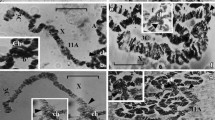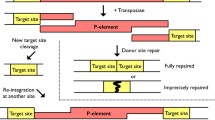Summary
A tandem duplication of the w +locus in Drosophila melanogasteris described. This duplication can exist in two distinctive states. In one state the duplication functions to evoke the zeste eye color phenotype in males. In the alternative state the duplication cannot so function. Spontaneous changes in state occur in both males and females. These changes are recovered as clusters in the absence of crossing over suggesting a premeiotic occur of the “mutation” event. In addition spontaneous male viable w deficiencies,are recovered from the tandem duplication existing in either functional state. These deficiencies, often recovered as clusters, originate in both males and females. It is suggested that these mutational events are causally associated with a segment of “foreign” DNA which has been mapped to the duplication. The nature of the mutational event is discussed.
Similar content being viewed by others
References
Gans, M.: Étude génetique et physiologique du mutant zeste de Drosophila melanogaster. Bull. biol. France Belg. (Suppl.) 38, 1–90 (1953)
Green, M. M.: Putative non-reciprocal crossing over in Drosophila melanogaster. Z. Vererbungsl. 90, 375–384 (1959a)
Green, M. M.: Spatial and functional properties of pseudoalleles at the white locus inDrosophila melanogaster. Heredity 13, 302–315 (1959b)
Green, M. M.: Unequal crossing over and the genetical organization of the white locus in Drosophila melanogaster. Z. Vererbungsl, 94, 200–214 (1963)
Green, M. M.: Some observations and comments on mutable and mutator genes in Drosophila. Genetics, Suppl. 73, 187–194 (1973)
Judd, B. H.: Analysis of products from regularly occurring asymmetrical exchange in Drosophila melanogaster. Genetics 46, 1687–1697 (1961)
Judd, B. H.: The structure of intralocus duplication and deficiency chromosomes produced by recombination in Drosophila melanogaster, with evidence for polarized pairing. Genetics: 49, 253–265 (1964)
Kriegstein, H. J., Hogness, D. S.: Mechanism of DNA replication in Drosophila chromosomes: structure of replication forks and evidence for bidirectionality. Proc. nat. Acad. Sci. (Wash.) 71, 135–139 (1974)
Lefevre, G. Jr., Green, M. M.: Genetic duplication in the white-split interval of the X chromosome in Drosophila melanogaster. Chromosoma (Berl.) 36, 391–412 (1972)
Rasmuson, B., Green, M. M., Karlsson, Britt-Marie: Genetic instability, in Drosophila melanogaster: evidence for insertion mutations 133, 237–247 (1974)
Author information
Authors and Affiliations
Additional information
Communicated by E. Hadorn
Rights and permissions
About this article
Cite this article
Rasmuson, B., Green, M.M. Genetic instability in Drosophila melanogaster . Molec. Gen. Genet. 133, 249–260 (1974). https://doi.org/10.1007/BF00267674
Received:
Issue Date:
DOI: https://doi.org/10.1007/BF00267674




